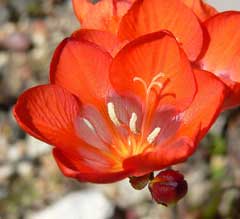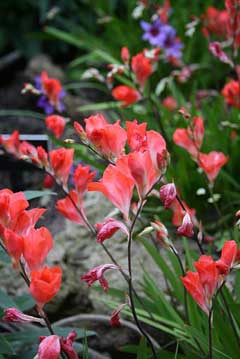 |
|
commons.wikimedia.org/wiki/User:Stan_Shebs |
 |
| commons.wikimedia.org/wiki/User:Epibase |
Translate this page:
Summary
Physical Characteristics

 Tritonia crocata is a CORM growing to 0.5 m (1ft 8in) by 0.1 m (0ft 4in).
Tritonia crocata is a CORM growing to 0.5 m (1ft 8in) by 0.1 m (0ft 4in).
See above for USDA hardiness. It is hardy to UK zone 9. It is in flower from May to June. The species is hermaphrodite (has both male and female organs) and is pollinated by Bees.
Suitable for: light (sandy), medium (loamy) and heavy (clay) soils. Suitable pH: mildly acid, neutral and basic (mildly alkaline) soils. It cannot grow in the shade. It prefers moist soil.
UK Hardiness Map
US Hardiness Map
Synonyms
T. hyalina.
Plant Habitats
Woodland Garden Sunny Edge; Hedgerow;
Edible Uses
Edible Parts:
Edible Uses: Colouring Condiment
The flowers are used as an adulterant of saffron in flavouring food and colouring it yellow[183].
References More on Edible Uses
Medicinal Uses
Plants For A Future can not take any responsibility for any adverse effects from the use of plants. Always seek advice from a professional before using a plant medicinally.
None known
References More on Medicinal Uses
The Bookshop: Edible Plant Books
Our Latest books on Perennial Plants For Food Forests and Permaculture Gardens in paperback or digital formats.

Edible Tropical Plants
Food Forest Plants for Hotter Conditions: 250+ Plants For Tropical Food Forests & Permaculture Gardens.
More

Edible Temperate Plants
Plants for Your Food Forest: 500 Plants for Temperate Food Forests & Permaculture Gardens.
More

More Books
PFAF have eight books available in paperback and digital formats. Browse the shop for more information.
Shop Now
Other Uses
References More on Other Uses
Cultivation details
Requires a sunny position, preferring a well-drained neutral to slightly acid soil with a pH in the range 6.5 to 7[200]. Requires moisture in the winter and spring followed by a dry period in the summer and early autumn[260]. A difficult plant to grow outdoors in Britain, it comes into growth in the winter and flowers in the spring[214, 260]. The growing plant is not hardy in the colder areas of the country, it tolerates temperatures down to between -5 and -10°c[200]. Closely related to T. squallida, apparently differing only in the colour of the flowers[200].
References Carbon Farming Information and Carbon Sequestration Information
Temperature Converter
Type a value in the Celsius field to convert the value to Fahrenheit:
Fahrenheit:
The PFAF Bookshop
Plants For A Future have a number of books available in paperback and digital form. Book titles include Edible Plants, Edible Perennials, Edible Trees,Edible Shrubs, Woodland Gardening, and Temperate Food Forest Plants. Our new book is Food Forest Plants For Hotter Conditions (Tropical and Sub-Tropical).
Shop Now
Plant Propagation
Seed - sow early spring in a greenhouse at 15°c[200]. It usually germinates freely[1]. Seed can also be sown as soon as it is ripe in the autumn in a warm greenhouse[200]. Sow the seed thinly so that the seedlings can be left undisturbed in the pot for their first two years of growth. Give them an occasional liquid feed in the growing season to ensure they do not become nutrient deficient. When the plants become dormant in the summer, pot up the small bulbs placing 2 - 3 bulbs in each pot. Grow them on for another one or two years in the greenhouse before planting them out when they are dormant in late summer. Division. Dig up the corms in October, dry them in well ventilated conditions at about 20°c and then store them in a cool but frost-free place over the winter, planting them out about 10cm deep in April[1, 200]. Corms should be planted out in the autumn[188]. Cormlets harvested when digging up the corms in the autumn can be stored in a similar manner to the corms[200]. Larger cormlets can be planted out in spring, smaller ones may be best grown on for a year in the greenhouse.
Other Names
If available other names are mentioned here
Native Range
EUROPE: France AFRICA: South Africa (Eastern Cape, Western Cape)
Weed Potential
Right plant wrong place. We are currently updating this section.
Please note that a plant may be invasive in one area but may not in your area so it's worth checking.
Conservation Status
IUCN Red List of Threatened Plants Status :

Growth: S = slow M = medium F = fast. Soil: L = light (sandy) M = medium H = heavy (clay). pH: A = acid N = neutral B = basic (alkaline). Shade: F = full shade S = semi-shade N = no shade. Moisture: D = dry M = Moist We = wet Wa = water.
Now available:
Food Forest Plants for Mediterranean Conditions
350+ Perennial Plants For Mediterranean and Drier Food Forests and Permaculture Gardens.
[Paperback and eBook]
This is the third in Plants For A Future's series of plant guides for food forests tailored to
specific climate zones. Following volumes on temperate and tropical ecosystems, this book focuses
on species suited to Mediterranean conditions—regions with hot, dry summers and cool, wet winters,
often facing the added challenge of climate change.
Read More
Expert comment
Author
(L.)Ker-Gawl.
Botanical References
200
Links / References
For a list of references used on this page please go here
Readers comment
© 2010, Plants For A Future. Plants For A Future is a charitable company limited by guarantee, registered in England and Wales. Charity No. 1057719, Company No. 3204567.